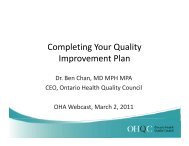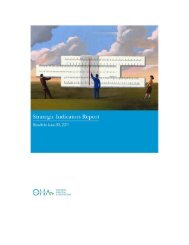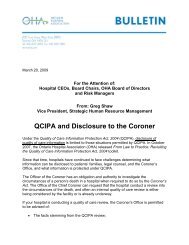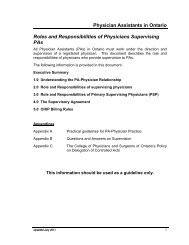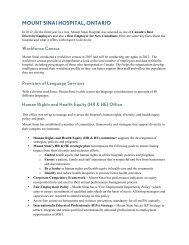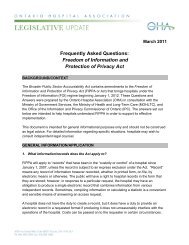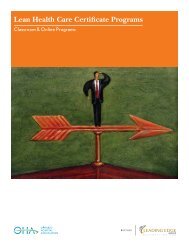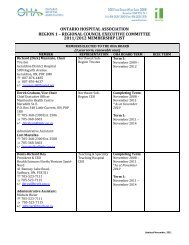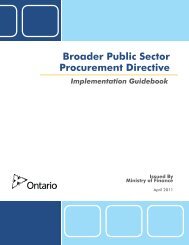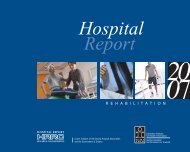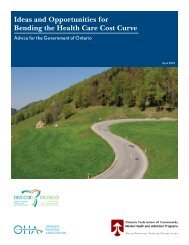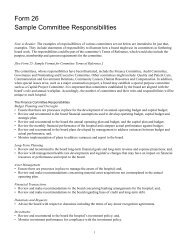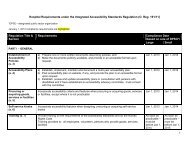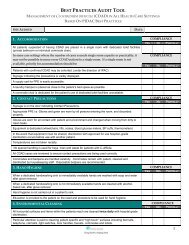The Relationship Between Employee Engagement and Human ...
The Relationship Between Employee Engagement and Human ...
The Relationship Between Employee Engagement and Human ...
- No tags were found...
You also want an ePaper? Increase the reach of your titles
YUMPU automatically turns print PDFs into web optimized ePapers that Google loves.
Executive Summary<strong>The</strong> <strong>Relationship</strong> <strong>Between</strong> <strong>Employee</strong> <strong>Engagement</strong> <strong>and</strong> <strong>Human</strong> Capital Performance report summarizesfindings from the Ontario Hospital Association’s (OHA) exploratory research project conducted in 2012with three pilot hospitals (one acute teaching, one community, <strong>and</strong> one small). <strong>The</strong> project examinesthe relationship between employee engagement <strong>and</strong> several key human resources (HR) metrics. This isthe first attempt by the OHA to link data from two of its major HR data initiatives: the OHA-NRC Picker<strong>Employee</strong> Experience Survey <strong>and</strong> the OHA-PricewaterhouseCoopers (PwC) Saratoga HR BenchmarkingSurvey.<strong>The</strong> project developed a methodology for accurately comparing <strong>Employee</strong> Experience Surveyengagement data with human capital metrics from hospital administrative data at the department level.It also identified three HR metrics – the full-time resignation rate, average sick days per full-timeemployee, <strong>and</strong> management span of control – which do appear to be related to employee engagementlevels at the department level. This research will provide HR leaders with support to build the case formaking investments in employee engagement. It appears that there are real costs associated withhigher absence <strong>and</strong> resignation rates when engagement is low.<strong>The</strong> project revealed four major technical issues organizations must consider when conducting this typeof analysis. First, survey response rates affect the representativeness of the survey findings. Lowerresponse rates introduce greater potential for non-response bias. A reasonable response target is 50%across the organization. However, for this research it is important that response rates in each of thedepartments are above average as well. In one of the pilot hospitals, the department response ratesvaried between 27% <strong>and</strong> 70%. Second, the accuracy of administrative data <strong>and</strong> the HR metrics used inthe analysis is also a key consideration. Missing or inconsistently collected HR administrative dataaffects the accuracy of HR metrics, <strong>and</strong> therefore the accuracy of comparisons with engagement scores.<strong>The</strong> third technical issue is that small departments may not have sufficient numbers of survey responsesto report engagement scores or HR metrics. Finally, the impact of extraneous factors must beconsidered. <strong>The</strong>re are a number of factors not measured in an engagement survey or in other HRmetrics that could introduce errors. For example, one hospital was undergoing major organizationalchange during the survey period. Also, metrics such as turnover are influenced by a range of personal<strong>and</strong> contextual factors.<strong>The</strong> methodology employed for this project was to a) compare HR metrics for departments with thehighest <strong>and</strong> lowest engagement scores, b)combine all department engagement scores <strong>and</strong> associatedHR metrics, <strong>and</strong> c)calculate correlation coefficients for relevant indicators. [Correlation coefficientsrange from +/- 1 to 0. Zero means there is no relationship between the two variables, <strong>and</strong> 1 means thereis a perfect correlation so that if one increases (or decreases, if the correlation is negative), so does theother.] Observations from the pilot hospital with the most reportable results include:• A correlation of -.45 between engagement scores <strong>and</strong> sick days for full-time employees, which ismoderately strong <strong>and</strong> in the predicted direction (higher engagement is associated with fewer<strong>Engagement</strong> - <strong>Human</strong> Capital Performance Report2



